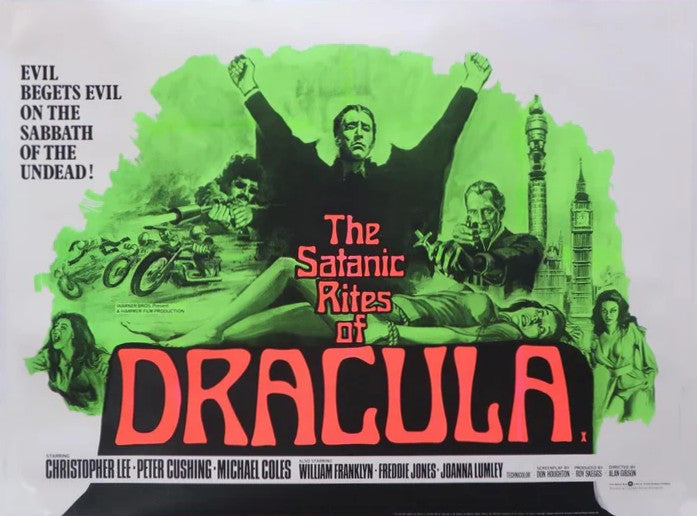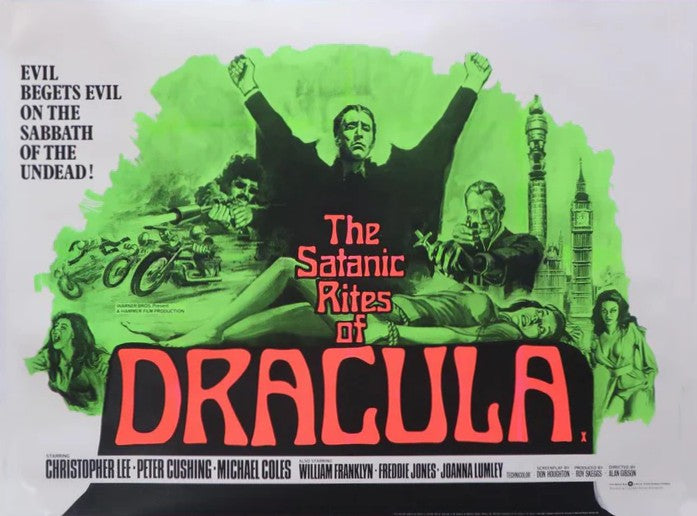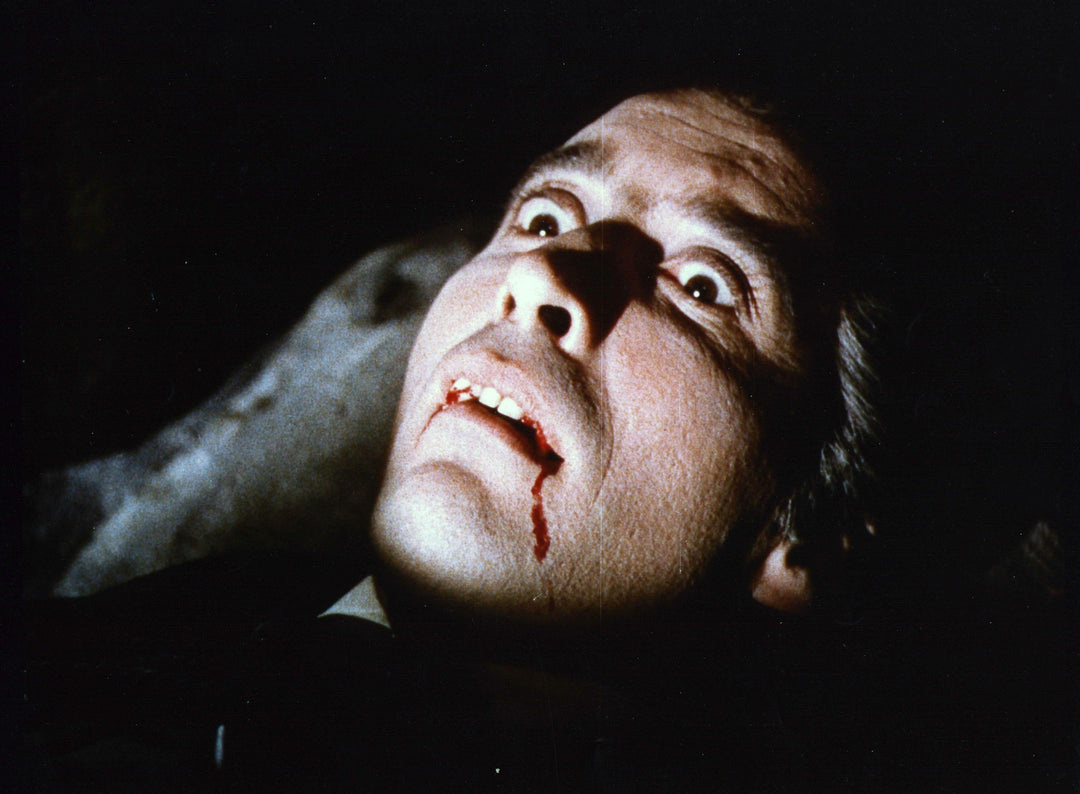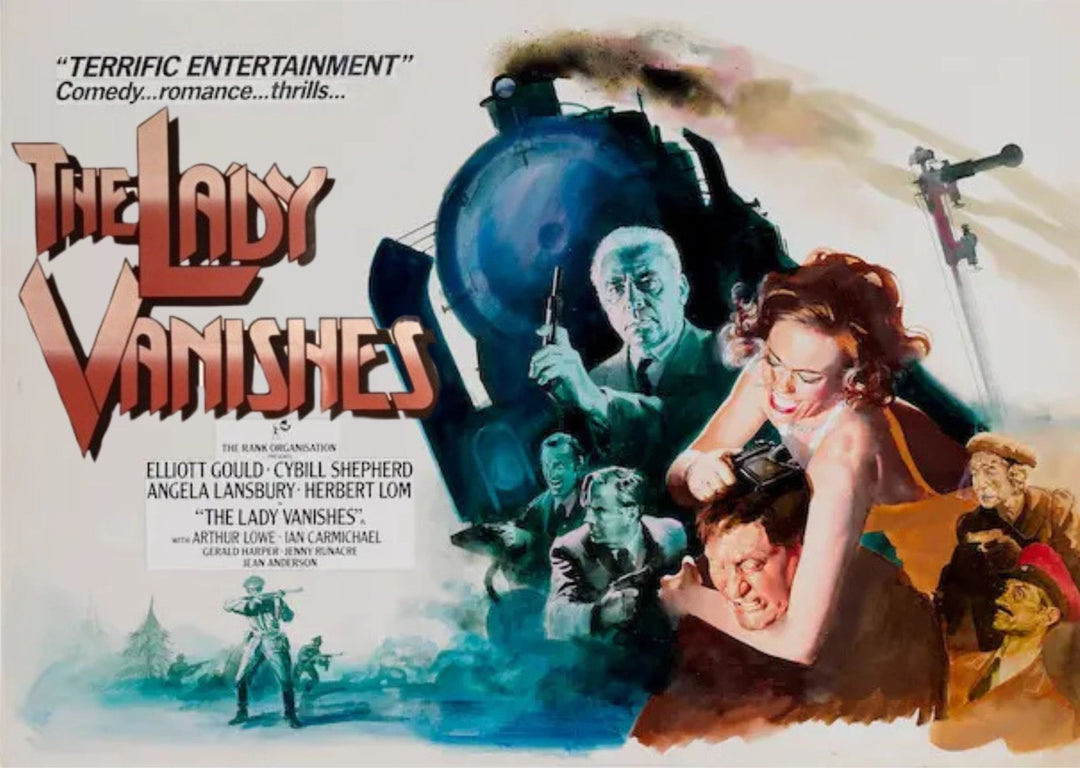The Count’s Last Bow, and the Beauty of Dracula’s Final Scene: Part One

Sneered at, jeered at and pilloried, The Satanic Rites of Dracula (1974) has been routinely derided for over half a century. It has been tried in the court of public opinion and found to be guilty. Of being ‘weak’, ‘silly and dull’ and even ‘a disgrace’. Its closing moments, depicting the ultimate death of Dracula, has been condemned with particular scorn. (‘The last nail in this film’s coffin is its insulting finale…’) All these opinions are valid, of course, simply because they are just that. Opinions. But this then, is the case for the defence.
Is The Satanic Rites of Dracula as effective as Dracula (1958), Hammer’s first film to pair Christopher Lee as the eponymous vampire alongside Peter Cushing as the stake-wielding Van Helsing? Of course not. Few takes on Bram Stoker’s iconic villain even come close to that classic. But is The Satanic Rites of Dracula the second best in the series? Is it the most complete, most audacious, atmospheric and original sequel? And is Dracula’s farewell scene a thing of melancholy beauty?
Well, yes, yes and most certainly yes.

The boy with a hawthorn in his side... Christopher Lee in his final moments as Dracula for Hammer.
Hammer made one more Dracula movie after this, The Legend of the 7 Golden Vampires (1974), which starred Cushing as yet another Van Helsing and John Forbes-Robertson as his ancient enemy. Some consider this to be part of the series established 16 years earlier, whilst others posit it’s a separate and distinct storyline. But however it’s viewed, that movie takes place decades before the events of Satanic Rites, meaning at best it’s a prequel. Pleasingly therefore, the concluding chapter of Hammer’s Dracula saga is told in the earlier picture. It feels fitting that this film’s confrontation between Cushing’s Van Helsing and Lee’s incarnation of the Count forms their characters’ definitive farewell.
Their final scene begins in one of Dracula’s country properties, Pelham House. (Incidentally, we’re defining ‘scene’ at its broadest here, interpreting it as ‘a unit of storytelling’. And yep, we’re aware that’s a bit of a cheat, but it feels important to cover Dracula’s death comprehensively!) A fire has broken out in Pelham House, just as Dracula has begun to unleash his new strain of bubonic plague. Throughout the film, this biological weapon has been spoken of in terms of flames. When assessing its threat, Lorrimer Van Helsing predicts that when dispersed, it will spread ‘like wildfire’. Later he describes the plague’s potential as being a ‘blaze of utter horror’, whilst Dracula, when outlining its effects, gloats, ‘In the first moments, every muscle, every fibre will be afire with torment and agony!’
But the only flames in evidence when the plague is released are actual, as opposed to figurative, and this very real, raging conflagration destroys the object of Dracula’s burning ambition. The one person (or ‘horseman’) who’s infected is consumed by flames, nullifying the threat he and the plague would have posed.

Lorrimer Van Helsing, fresh from Dracula A.D. 1972 (1972), is a man with a cross to bear.
In the Count’s very first scene in Dracula we see him stood in front of a line of tiny, flickering candles. Now those small fires are a huge blaze, emphasizing how out-of-control the situation has become. Not that he’s fazed by the inferno around him. On the contrary, appropriately enough, he looks right at home amongst these flames of hell. It’s as though they fuel him and despite the setback of losing his only plague-carrier, he becomes more maniacal than ever. Bathed in the dancing orange light of the fire, and with an unbridled level of gusto he declares to Lorrimer, ‘My revenge has spread over centuries… and has just begun!’
This bravado proves hollow, and ironically the boast winds up becoming Dracula’s last words. It’s an appropriate line of dialogue to go out on as it’s a slight tweak of two sentences spoken by the character in Chapter 23 of the original novel. (Curiously, Stoker’s text – ‘My revenge is just begun. I spread it over centuries and time is on my side’ – feels more modern that its cinematic iteration.)
Lorrimer Van Helsing doesn’t fancy his chances with a vampire in a burning building and scarpers into the forestland that edges the house. We see the sole plague victim devoured by the flames and the other remaining good guys effect their escape. Only one storyline remains to be resolved. And so, as Dracula pursues Van Helsing, just as he pursued his ancestor generations earlier, we sense we’re rocketing towards not simply the film’s climactic confrontation, but the entire epic tale’s final reckoning.

French marketing material for The Satanic Rites of Dracula.
It's a terrific start to the movie’s finale, full of lines inspired by the novel, which must have delighted Lee who kept a copy of the book on him throughout filming. His performance here is one of his strongest throughout the entire series; imperious in the face of disaster, driven by hatred, cruelty and self-interest.
Terence Fisher, who directed Lee’s first two outings as Dracula, labelled the character ‘the embodiment of evil’, and he certainly lives up to that billing here. What Lorrimer describes as, ‘a ghastly annihilation of an entire planet’, he simply views as ‘my final conquest’. He takes a sadistic delight in taunting his adversary about the power her holds over his granddaughter, Jessica. ‘Van Helsing, I choose the spawn of your blood to be my consort… the body of your granddaughter will never be corrupted.’ Note his use of the words consort and body, with all their attendant implications.
And literally the only time he smiles comes as he enjoys one of his minion’s screams of agony and horror as the poor old chap becomes lethally infected. In that second Christopher Lee personifies the Count as Stoker described him in his novel: ‘I saw Dracula… with a red light of triumph in his eyes, and with a smile that Judas in hell might be proud of.’

Dracula plans to release the plague in a quasi-religious ceremony conducted at Pelham House.
Not to be outdone, Cushing captures his character’s calm revulsion as though he were born to play Van Helsing, which looking back, is an entirely plausible supposition.
Picture yourself in one of those cavernous, cigarette smoke-filled cinemas in the winter of 1974, when the film first played. As Dracula flees the flames to hunt down his nemesis, can you imagine a single member of the audience could have torn their eyes from the screen, let alone left the auditorium to beat the exit rush? No. Because this is Dracula as it was always meant to be. Jammed with jeopardy. Operatic. Immediate. Wild and rousing and terrifying.
THIS is a Hammer Film.

Joanna Lamond Lumley had previously appeared in On Her Majesty's Secret Service (1969) and The House That Dripped Blood (1971). She recently returned to horror with a recurring role in Wednesday.
Quite aside from these gripping moments, the film delivers plenty more to relish. The plot gallops along and throughout a number of scenes shot in the capital, 1970s London is captured in a kind of gorgeously grim way. Christopher Lee deploying a Hungarian accent during one exchange, as a personal tribute to Bela Lugosi, is a lovely touch, and handing Dracula more temporal power (he’s the puppet master of politicians and security chiefs) comes as a welcome development, emphasizing his guile and power. Lee and Cushing are on riveting form and other members of the cast prove to be terrific foils. Freddie Jones is a hoot as the bonkers Doctor Julian Keeley, and Joanna Lumley (a replacement for Stephanie Beacham who played Jessica in the previous entry) is enormously likeable as Lorrimer’s inquisitive grandchild.
And yet The Satanic Rites of Dracula somehow acquired a poor reputation, and to find out why, we need to return to its beginning…
Filming on the production concluded on January 3rd, 1973, fifteen years to the day since shooting wrapped on Dracula. But what a difference a decade and a half makes. The optimism that surrounded the first movie had long since curdled and everyone, it seems, felt setting this new film in the present day was a risk that wasn’t paying off. Assistant Director Derek Whitehurst later confessed, ‘We all felt it was scraping the bottom of the barrel.’
Even before it was released, one critic was particularly savage about the work, branding it ‘fatuous, pointless [and] absurd’, which wouldn’t have been so bad, except the critic in question was Christopher Lee, who happened to be playing the title character. Safe to say it wasn’t his most cherished piece of work. ‘I’m doing it under protest,’ he said of his involvement in the picture, in case anyone hadn’t got the message. ‘I just hope they [the audience] realise that I am struggling against insuperable odds… to remain true to the author’s original character.’

Discussing the team behind the Hammer Draculas, Lee stated ‘All the crew were my friends. It was like a family… It really was.’
But Lee’s fraught relationship with the Count stretched back over many years. He declined to appear in the first sequel, The Brides of Dracula (1960) and when - a full 8 years after his vampiric debut - he finally agreed to don the fangs and cape again, for Dracula: Prince of Darkness (1966), he was vocal about his dissatisfaction concerning its screenplay. Famously, his character doesn’t utter a word in the movie and Lee later explained, ‘The reason was very simple. I read the script and saw the dialogue! I said to Hammer, If you think I’m going to say any of these lines, you’re very much mistaken.’
He had similar feelings about Taste the Blood of Dracula (1970), opining ‘after an initial burst the story drooped’, and he branded the next entry, Scars of Dracula (1970), ‘truly feeble’. Indeed, such were his misgivings, his appearance in that film was reportedly touch-and-go, with John Forbes-Robertson sounded out about taking over the part.
In other words, his criticism of The Satanic Rites of Dracula was nothing new and should not be taken as a sign that this sequel represented a sudden dip in quality. Studio exec (and friend of Lee’s) Michael Carreras even suggested the actor’s oft repeated disdain was less an indication of his true feelings, and more a canny way of maintaining the interest of journalists writing about his output.

Lee may not have liked Taste the Blood of Dracula, but reviewing the movie, the Los Angeles Times wrote that he ‘seems to take new interest in the role with a terrifyingly bloodshot performance.’
Whilst it’s hard to dismiss Lee’s stated views as nothing more than a marketing ploy, there may be a kernel of truth in the observation. Lee played the Count seven times for Hammer, once for a European consortium-funded adaptation, once for Jerry Lewis (no, really) in the knock-about One More Time (1972) and later returned to the role for the French comedy horror, Dracula père et fils (1976). He accepted the position of President of the Dracula Society and even named his cat ‘Renfield’, after the character in Stoker’s novel, because it had a habit of eating flies! This is not the MO of a man who wishes to distance himself from the world’s most famous vampire.
But the exact reason behind his criticism of The Satanic Rites of Dracula is perhaps academic. The more pertinent question remains, to what extent did his very public disparagement impact on people’s perception of the film? It’s impossible to quantify, but his contempt certainly set the tone. It’s hard for critics to praise or even defend a movie when its most prominent star is insisting it’s ‘pointless’.
As noted above, reviewers weren’t kind to the movie upon its release, but more recent commentators have shown greater positivity. Mark Gatiss found it ‘gritty and very creepy’, and the BBC was at least even handed in its summation: ‘[a] very silly film but also a hugely entertaining one’. A review in Horror Cult Films believes the picture, ‘never binds its disparate elements into a unified whole’, but concedes ‘… it deserves some praise for its audacity, and is certainly rarely dull.’
Writing for the EOFFTV Review in 2021, Kevin Lyons was more enthusiastic: ‘The Satanic Rites of Dracula fizzes with energy from the first frame to the last, introducing all sorts of thriller, spy film and science fiction elements into the mix to surprisingly good effect.’ Hear hear! Lisa Marie Bowman was equally willing to give it the thumbs up in her assessment for Through the Shattered Lens, calling it, ‘one of the more reviled entries in the series… but you know what? I think The Satanic Rites of Dracula is actually rather underrated. If nothing else, it’s certainly far more unpredictable than some of the far more critically embraced Dracula films.’

Lorrimer displays this striking artwork at his home – not that he’s obsessed with Dracula in any way…
Agreed! The plot represents a huge improvement on the previous sequels’ storylines. Here, a covert branch of British Intelligence has been monitoring a well-connected cult who practice satanic rituals in a large residence in the English countryside, Pelham House. They discover important public figures are involved and rope in Professor Lorrimer Van Helsing (descendant of the OG vampire hunter, Doctor Van Helsing) to help with their investigations. He deduces the cult is serving a newly risen Count Dracula and that one of its members has developed a new strain of the bubonic plague that once liberated, may be unstoppable. Lorrimer theorises that his old rival intends to wipe out all mankind. This will deprive him of the necessary sustenance he needs to survive, and so humanity’s death will bring about his own irrevocable demise.
The funding for the plague’s development has been paid for by D.D. Denham, a fabulously wealthy recluse who spends most of his time in his office tower block, recently built on the site of the church where Dracula was apparently killed by Lorrimer two years earlier.
Alarm bells ringing, the Professor visits Denham and finds the businessman is actually – you guessed it – Drac-u-la! Lorrimer is captured and taken to Pelham House where Jessica V.H. and our old friend Inspector Murray (again played by Michael Coles who returns after his stint in Dracula A.D. 1972) are already held prisoner. Lorrimer pleads with his host to do the decent thing, but is essentially told no dice, as Dracula prefers to trigger ‘my created apocalypse’.

Lorrimer watches on as the Count’s plans are shot down in flames.
Meanwhile, stuck upstairs, Murray has a fight with a guard which starts a fire that rapidly spreads. In the ensuing confusion, Jessica is saved and the blaze destroys the plague before it can be passed on. Dracula escapes and chases Lorrimer who’s legging it through some nearby woods. But after injuring himself on the thorns of a hawthorn bush, deadly to vampires, he’s killed when the latest Van Helsing continues the family tradition of driving a wooden stake through his heart.
If all that sounds like a crazy, breathless, thrilling riot of a ride, well, that’s because it is.
What’s not to love about a film in which Dracula intends to destroy every living person on the planet? In previous entries he’d been content to pick off a few tourists or to simply survive. But here, at last, he has a vast, vile, chilling scheme. Hell bent on unleashing hell, or as Lorrimer expresses it, his plan is ‘to bring down the whole universe with him! The ultimate revenge! Thousands dying of the plague… like the shadow of death itself – one figure scything its way through the terror and anguish. Count Dracula! It is the biblical prophecy of Armageddon!’
Wow! This raises the stakes to stratospheric levels! This is no petty feud between Dracula and the Van Helsings. No tussle over a figure confined to a castle in the middle of nowhere. This is a battle for the existence of mankind, fought between our world’s greatest vampire hunter and a foe whose resources are as limitless as his evil.

Caroline Munro called Dracula A.D. 1972 ‘…a very brave move by Hammer because it was so out there… a lot of people thought, Wow, what is this film?’
In Dracula A.D. 1972 Christopher Lee, uncertain about the wisdom of ushering Dracula into the modern age, had insisted his character remained within the premises of St. Bartolph’s Church in London where he’s ultimately defeated. But in this follow-up film he’s set free, abroad in our environment. Truly, Dracula has risen from the grave with – at last! – a grand, grisly purpose and a deadly drive…
In Part Two of The Count’s Last Bow, and the Beauty of Dracula’s Final Scene we’ll be looking at the end of more than one era for Hammer, saluting Lee’s farewell moments as the studio’s Count Dracula, exploring the myths surrounding the film’s release, and revealing why those famous final scenes turned out to be much bloodier than anticipated…


